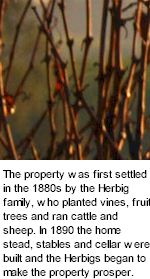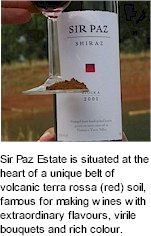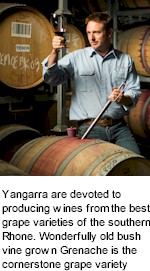| |
|
|

|
|
|

|
The distinctive chalk cliffs of the Champagne region extend under the English Channel to resurface in Sussex as the South Downs
Viticulture Has Been A Softly Spoken Industry Here Since Roman Occupation The propitious limestone escarpments and temperate seasons making a super clime for the production of exquisitely balanced sparklings The sacred trinity of Champagne varietals, dominated by Pinot Noir and Pinot Meunier, a measure of Chardonnay for structure and finesse, its comely pink blush is matched by the ripe red tang of cranberries, morello and sweet Seville orange spice.
|
|
|
There really is a Devil's Corner and it's a section of Tamar River
VERY NEAR KAYENA VINEYARD. The lee is a calm area of refuge for sailors away from the potentially wild waters of Whirlpool Reach to the south. it has been used as such for over two hundred years. Devils Corner are Tasmanian wines of the highest order. reflecting the natural variations engendered by climate and soil. Crafted from East Coast and Tamar Valley fruit. a Chardonnay wine of beautifully preserved Tasmanian bucolic charm. to accompany creamy risotto and the freshest fishes. .
|

EXCELLENT LANGTONS CLASSIFICATION. Named for the contribution of Johann Gramp's grandson to the Orlando Wine Company, St Hugo is the very best varietal Cabernet Sauvignon of vintage. Hugo is vintaged entirely from fruit grown to the famed cigar shape of Coonawarra Terra rossa, one of the world's great Cabernet appellations. The team regularly visit the vineyards monitoring development of grapes. Selection is the key to delivering the finest possible St Hugo, only the standout parcels of Coonawarra Cabernet are earmarked for inclusion.

PREVIOUS VINTAGE CLAIMED TROPHY AT CAIRNS BEST WINE FOR ENJOYMENT IN THE TROPICS! Winemaker Ross Pamment has fashioned a gorgeous Rose, voluminously flavoured in mature adults only styling. The Brookland Valley team gave quite a bit of thought as to an appropriate style for the cool maritime Margaret River and came up with a mainly Merlot and Cabernet Franc blend. A vibrantly pink wine that's undergone short term skin contact, Verse 1 entices the nose with fragrances of raspberry and rose petal, a deeply flavoured palate and pleasant lingering finish.

COCKATOO RIDGE IS HEADQUARTERED IN THE BAROSSA VALLEY ON THE PRINCIPAL ROAD BETWEEN THE TWO MAIN BAROSSA TOWNS OF TANUNDA AND NURIOOTPA. This high profile site was once the old Hardy's Siegersdorf winery, built in 1930. Cockatoo Ridge NV is blended between two or three years harvest to provide consistency, reliability and a rounded flavour. An internationally recognizable Aussie Sparkler, it carries a trademark pink hue which delivers a broad palate, flavoursome and fruit driven. A deliciously reliable Sparkling wine with complexity and depth of flavour.

DESCRIBED BY THE LONDON OBSERVER AS AUSTRALIA'S FINEST PINK WINE, Rose of Virginia is distinctively perfumed thanks to the inclusion of a choice Grenache component, followed by the brooding characters of noble red grapes. At a time when growers were pulling out their vines to plant more fashionable varieties, Charlie was convincing farmers to keep their historic parcels of Grenache. Just ever so slightly away from the cloying, rich styles, Rose of Virginia is crisp and balanced to match the wide range of cuisines which have been her partners.
|
Glen Eldon Wines
is a family owned and operated winery established by Mary and Richard Sheedy in 1997
Glen Eldon Wines has vineyards located throughout the Barossa Floor and Eden Valley, each one selected for it’s micro-climate and distinctive flavour attributes for the final wine in mind. The main vineyard and cellar is located at the Glen Eldon property in Eden Valley, it was only fitting to honour this brand with the Glen Eldon name. The property was first settled in the 1880s by the Herbig family, who planted vines, fruit trees and ran cattle and sheep. In 1890 the homestead, stables and cellar were built and the Herbig Family began to make the property prosper. Today Richard and Mary call Glen Eldon home. All the vineyard and winery operations are centralised from their headquarters at Glen Eldon.

Prior to launching his family label of Glen Eldon Wines, Richard gained his experience as Winemaker/ General Manager at Elderton and previously at St Hallett Wines. Mary and Richard have successfully built Glen Eldon into a premium winery specialising in regional wines of distinctive quality. Glen Eldon today produces premium wines that display the world known and admired characters of the Barossa.
The Barossa is made up of the Valley floor and the Barossa Ranges (Eden Valley) and has built the reputation as Australia’s premier viticulture and winemaking region. Vines were first planted in the Barossa in the 1850’s and today the Barossa is alive with prosperity from the wine and associated industries.
Barossa Shiraz, Cabernet Sauvignon and Eden Valley Riesling have offered distinctive regional characters that have captured the imagination of wine drinkers the world over, it was with this tradition and quality that the Barossa was selected as the home for the Sheedy Family winery.
With vineyards in Tanunda, Mt McKenzie, Springton and North East of Mt Pleasant, Glen Eldon have the ability to select only the best parcels of fruit for winemaking. These vineyards all offer distinctive sub-regional characters. The variation in soil, rainfall, row facing and pruning, combined with attention to detail in vineyard management, consistently produce premium fruit.
The philosophy is to highlight the regional characters to the fullest. Modern winemaking knowledge is fully utilised for quality control. Traditional vinification techniques also have their place. Glen Eldon continue to ferment wines in traditional open fermenters with heading down boards and pump over regularly for full flavour and colour extraction. A mixture of French and American hogsheads is employed for barrel maturation. Ageing is dependent on each parcel, but generally carried out for eighteen to twenty for months. All wooded wines are remarkable for their well integrated oak and fine tannins. Theie sensational Eden Valley whites display brightly lit fruit, distinctive varietal expression, and clean varietal characters.
Sir Paz Estate
was established by the Zapris family in 1997 at Silvan, a picturesque wine producing town of the Yarra Valley, also noted for its market gardening farms
The Yarra Valley has a rich and romantic history as a wine producing region, extending back to 1838 when the first vines were planted by Swiss settlers. By the turn of the century, some 800 acres of prime land had been planted with vines, and the region quickly developed a reputation for producing excellent table wines. Over time, the demand for fashionable fortified wines such as muscat and port increased. This resulted in many winemakers abandoning their vines, unable to earn a living from their produce. By the early part of the 20th century most vineyards in the Yarra Valley had ceased operating. With the resurgence of interest in wine in the late 1960s and early 70s, more and more vineyards were established in the area with growers planting Shiraz, Chardonnay, Pinot Noir and Cabernet Sauvignon varieties.

The most sought after area of the Yarra Valley was a unique belt of volcanic terra rossa (red) soil, famous for consistently producing wines of extraordinary flavours, wonderful bouquet, and rich sublime colour. Sir Paz Estate is situated at the heart of this belt, and is privileged to be part of the enduring history of winemaking in the Yarra Valley.
Formerly a chestnut tree grove, Sir Paz Estate was established by the Zapris family in 1997. The vineyard is located on 35 acres of red volcanic soil in the southern hills of the Valley, idyllically surrounded by cherry and berry orchards. The elevated site suits viticulture perfectly; grapes experience true cool climate conditions, ripening slowly for maximum flavour development. In some seasons, the Shiraz is picked approaching winter in mid May!
The most important element of making first class wine is in the preparation of the vineyard and fruit prior to harvesting. All of the Sir Paz Estate wines are made from grapes strictly grown in the vineyard where the Zapris Family works closely with the estate manager in monitoring flavour development and degrees of ripeness to determine harvest dates. Particular sections of the vineyard are harvested at different times, depending on the variety of the grape and seasonal climatic conditions.
All fruit nonetheless is hand-picked rather than machine harvested, and crushed immediately to minimise the effects of oxidation. Sir Paz also maintain a policy that 40% of all barrels used are new - French and American oak. The wine making processes are then based on the respective varieties and vintage attributes.
First class winemaking begins in the vineyard. This has been the maxim of Sir Paz Estate since the first vines were planted. The Sir Paz 35 acre estate has 4 distinct varieties, Shiraz, Merlot, Chardonnay and Viognier. Clonal varieties have been meticulously selected to suit terroir, and vineyard management remains the primary focus. Vines are cropped at 1 ½ tonnes per acre, and all grapes are picked by hand. It is the Sir Paz policy to grow no more than 1 to 2 tonnes of grapes per acre, maximising concerted efforts to produce the highest quality wine at all times. French oak hogsheads are exclusively used in maturation, with a minimum of 30% new oak for all red wines. Every Sir Paz Estate wine released is offered in the spirit of upholding and maintaining the stellar reputation that the Yarra Valley has today, achieved.
Henschke is one
of the longest established family names in the Barossa
Johann Christian Henschke purchased land for a farm at Keyneton in 1861, after fleeing religious persecution in Silesia. He planted a small vineyard and an orchard, and after initially making wine for family consumption produced his first commercial vintage in 1868, believed to be principally riesling and shiraz. Each subsequent generation built upon the reputation for quality, but it was fourth-generation Cyril Alfred Henschke who in 1958 created the wine that has most captured the red wine world's imagination - Hill of Grace.

The original two-storey cellar, built into the side of the hill in time for the 1868 vintage, has been added to throughout the generations. Now covered with ivy, the stone building retains an old-world charm with its open fermenters and winemaking memorabilia on display. The estate's Mount Edelstone, Hill of Grace, Eden Valley and Lenswood vineyards produce the range of Henschke wines. Managed by viticulturist Prue Henschke, the superlative vineyards bear the fruit of her leading edge research and development. They vary from venerable dry-grown shiraz vineyards to the newer cooler-climate Lenswood vineyards supporting varieties such as pinot noir, chardonnay and merlot.
The original two-storey cellar, built into the side of the hill in time for the 1868 vintage, has been added to throughout the generations. Now covered with ivy, the stone building retains an old-world charm with its open fermenters and winemaking memorabilia on display. The estate's Mount Edelstone, Hill of Grace, Eden Valley and Lenswood vineyards produce the range of Henschke wines. Managed by viticulturist Prue Henschke, the superlative vineyards bear the fruit of her leading edge research and development. They vary from venerable dry-grown shiraz vineyards to the newer cooler-climate Lenswood vineyards supporting varieties such as pinot noir, chardonnay and merlot.
The beautiful and historical name Mount Edelstone is a translation from the German edelstein, which means gemstone
In 1839 Johann Menge, a German geologist, mineralogist and gardener explored and surveyed the regions around Adelaide in the new free colony of South Australia, on behalf of George Fife Angas and Colonel William Light. He travelled through the Barossa Range, giving names to the rivers and hills, including Mount Edelstein, which with time was anglicised to Mount Edelstone. The 40-acre Eden Valley vineyard, was planted to shiraz, probably sourced from Joseph Gilbert at Pewsey Vale. The original pre-phylloxera material most likely originated from the James Busby selection, which was propagated by Samuel Smith of Yalumba in the 1850s. What is surprising about Mount Edelstone is that it was planted purely as a shiraz vineyard.
Hill of Grace is surely is one of the most evocative phrases in the world of wine. For Henschke it is the name of both the vineyard and the wine that has so captured the heart of the red wine lover. The land was originally granted to Charles Flaxman in 1842 for £1 per acre. It was then sold by George Fife Angas to Nicolaus Stanitzki in 1873, for £480. Paul Gotthard Henschke purchased the vineyard in 1891. After his death his sons and executors Paul Alfred and Julius Philip Henschke arranged the transfer to Julius Philip, who had married into the Stanitzki family. In 1951 the property was purchased by Louis Edmund Henschke, a son of Paul Alfred Henschke, who worked the vineyard and property for nearly 40 years. The family continues to maintain the heritage.
The eight-hectare vineyard on the original 32-hectare block sits at an altitude of 400 metres, and has an average rainfall of 520 millimetres. It is situated on Parrot Hill, an isolated spot that was once an active village. Hill of Grace is planted predominantly to shiraz, but a surprise to many is that it also includes other varieties. Riesling, semillon and mataro/ mourvedre, with the sercial grape now only a distant memory. This diverse planting of several varieties in the garden, as the old Barossan growers called their vineyard, is typical - a sort of hedging their bets against the vagaries of mother nature. The whites are used in Eden Valley varietals, and the mataro...well, that's one of mother nature's later maturing varieties. It has gone into Hill of Grace at times, but usually it just doesn't ripen enough.
The Yangarra philosophy
is all about making the finest estate grown single vineyard wines which reflect an authentic sense of place
The story begins in 1862, when Ebenezer Ward was the most colourful wine critic of his day, he described the grounds of Yangarra as a gigantic pyramid of verdure, its slopes and summit clothed with luxuriant vines. After a century of viticulture, the site was re developed in 1946 by one of McLaren Vale's most distinguished vignerons. Bernard Smart’s name remains synonymous with many of the old vine plantings which dot the Blewitt Springs Clarendon districts and produce the region's most compelling Grenache wines. For many years, the fruit of the 1946 Yangarra plantings was sought by winemakers who used it as an important component of their icon wines.

In the year 2000, California pioneers Jess and Barbara Jackson began their search in Australia for a site that could produce world class wines. Their endeavor culminated a year later when they discovered the estate and fell in awe of the gnarly, old bush vines that deliver the heart and soul of Yangarra. The property is 170 total hectares, of which nearly 90 hectares are planted to vine. The remaining 80 hectares are preserved for native vegetation and wildlife and is intended to enhance the symbiotic relationship between the vines and their natural environment. Yangarra’s combination of rare geologies, moderate altitude, abundant sunshine and cool evening breezes make it perfect for growing varieties that thrive in the moderate maritime Mediterranean environments.
Yangarra are devoted to producing wines from the best grape varieties of the southern Rhone. Old bush vine Grenache is the cornerstone grape variety. Yangarra Estate is further planted with a diverse number of varietals, including traditionals like Shiraz and Roussanne to more obscure varieties such as Bourboulenc and Picpoul Noir, Clairette Blanc and Counoise.
With a tendency towards experimentation, Yangarra was the first in Australia to commercially plant Grenache Blanc. The uncompromising attention to detail in the vineyard follows through to the winery. A sensitive and gentle hand in the winemaking, constant observation and knowing when not to interfere are key pillars aimed solely at preserving the natural characters that originate from a distinctive vineyard.
The dedicated team Yangarra draw inspiration upon the tried and tested techniques of old, such as wild fermentation, basket pressing, amphoras, ceramic eggs and large format oak foudre. They aim to make a classic and timeless style of wine, remaining true to varietal character and recognizable to admirers of other global benchmarks. Applying biodynamic preparations promote beneficial soil microbial biomass, natural composting processes through mulching grasses under vine back into the soil, building organic matter. Grazing sheep through winter helps to control grasses throughout the vineyard, naturally fertilising soils and reducing compaction from tractors. Yangarra Estate and its wines have steadily gained respect and acclaim within Australia and beyond our shores. Though maintaining a progressive trajectory towards the future, Yangarra continues to take inspiration from its earlier days, grateful for visionaries like Smart and Jackson who endowed custodianship of this prized land and history.
Through strict biodynamic regenerative farming practices and sensitive winemaking philosophies, Yangarra's respect of this special piece of country is evident in the wines. Every Yangarra Estate wine is a confident reflection of this great and fortunate land.
|